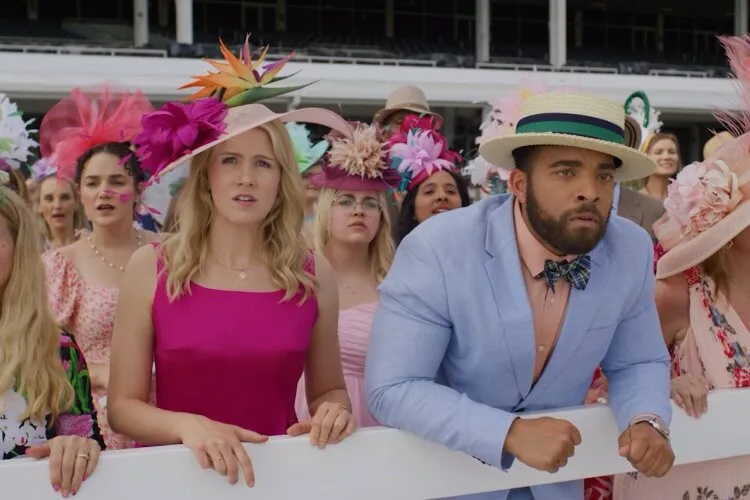The world of the Louisville Derby feels like a meticulously designed game level, a space governed by its own strict rules of fashion, tradition, and social standing. Into this vibrant arena steps our protagonist, Stella, a skilled milliner with a clear objective: conquer this world by winning the coveted Bradbury Prize for her hat designs.
Her initial quest involves getting her work noticed by the scene’s most influential figure, the elegant socialite Rosalind Fairchild. Success here unlocks the next stage of the story. Along the way, she has a classic meet-cute with Rosalind’s son, Christian, a horse trainer who represents the game’s primary romance path.
The central conflict is immediately established. Stella must use her creative skills to level up, all while facing off against professional rivals and learning the unwritten rules of a society that sees her as an outsider. The narrative sets up a familiar, comforting loop of ambition and connection.
The NPCs of High Society
A film like this functions much like a story-driven RPG, and its success depends on the quality of its characters, or non-player characters, that populate its world. Ginna Claire Mason’s Stella is an effective player-character, an earnest and optimistic person whose farm-bred sincerity feels out of place in the high-stakes social environment.
Her kindness is a resource, but it also lowers her defense against manipulation. John Clarence Stewart plays Christian, the main companion character, with a gentle charm. The script, however, gives him dialogue and actions that sometimes feel underdeveloped, especially when his poor judgment creates manufactured conflict.
The true standout is Holly Robinson Peete as Rosalind Fairchild. She is the dignified quest-giver, a character written and performed with a quiet strength and warmth that gives the world its emotional anchor. The antagonistic figures, Odette and Hannah, represent two sides of the rival trope.
Odette is the classic gatekeeper, the stern professional whose initial hostility gives way to a grudging respect in a satisfying arc. Hannah is a saboteur, whose actions are fueled by a jealousy the script works to explain. The attempt to make her actions understandable by showing her feeling ignored is present, though its effectiveness will vary for each viewer.
Crafting Quests and Social Links
The narrative structure of Hats Off to Love will feel familiar to anyone who has spent time with crafting or life-simulation games. Stella’s professional life is a series of design challenges, a crafting system where she must use her knowledge to create hats that meet specific criteria for Rosalind.
This mechanical progression is paired with the development of her relationship with Christian. Their “quid pro quo” bargain—her calming his horse in exchange for his social intel—is a classic game mechanic for building affinity between two characters. Their bond grows through these shared tasks, moving the romance forward.
The subplot involving Hannah’s sabotage introduces conflict that tests Stella’s progress. These moments, while necessary for the drama, occasionally stretch believability; Stella’s inability to detect the scheming at times makes her seem a bit too naive.
The Kentucky Derby setting itself is more than just a backdrop; it is the entire game board. It dictates the high-pressure stakes, the aesthetic of the film, and the rhythm of the plot. The hats, the central crafting element, are a mixed bag visually, with some designs appearing more successful than others.
The Final Score
Hats Off to Love is a polished entry in its genre, a game that knows its audience and executes its formula with proficiency. It does not attempt to reinvent the romantic drama, but it refines it with a set of strong performances and a welcome commitment to its supporting cast.
The story provides its female characters, particularly Rosalind and Odette, with small but meaningful arcs that add texture to the world. The film’s primary weaknesses are moments in the script that weaken its logic; the idea that a professional horse trainer needs tips from a milliner is a difficult premise to accept.
Christian’s gullibility also creates friction that feels forced. For viewers who enjoy light, character-focused romance, this is a charming and heartfelt experience. The strength of the cast makes it a pleasant and easy watch, a recommended playthrough for anyone seeking a low-stakes story with a sweet emotional payoff.
Hats Off to Love is a 2-hour feel-good romance that premiered on the Hallmark Channel on May 3, 2025, at 8 pm ET, timed to coincide with the Kentucky Derby weekend . It immediately became available for streaming the next day on Hallmark+ and can also be watched on platforms like Philo, Sling TV, Hulu + Live TV, YouTube TV, Fubo, and Frndly TV.
Full Credits
Director: Amy Barrett
Writers: Austin Highsmith Garces, Amy Barrett
Producers and Executive Producers: Danny Roth (with company RNR Media; executive producers include John Mehrer, Joseph Wilka)
Cast: Ginna Claire Mason, John Clarence Stewart, Holly Robinson Peete, Rena Strober, Darla Delgado, Alex Trumble, Kristin Wollett, Holly Ward, Cindy Karr
Director of Photography (Cinematographer): Wendy Elford‑Argent
Editors: Wendy Elford‑Argent
The Review
Hats Off to Love
While its narrative follows a familiar blueprint, Hats Off to Love is a charming experience. Strong performances from the cast, particularly a graceful turn by Holly Robinson Peete, elevate the material and compensate for some questionable logic in the script. It doesn't attempt to innovate on its genre's formula, but it executes that formula with enough polish and heart to make it a worthwhile watch for its intended audience. It is a pleasant, well-acted piece that delivers exactly what it promises.
PROS
- Excellent supporting performances, especially from Holly Robinson Peete.
- The story provides satisfying character development for its female cast.
- A consistently charming and heartfelt tone.
- The Kentucky Derby setting offers a fresh visual backdrop.
CONS
- The plot relies on some unbelievable story points.
- The main romance can feel underdeveloped due to the male lead's inconsistent characterization.
- Follows a highly predictable narrative path.
